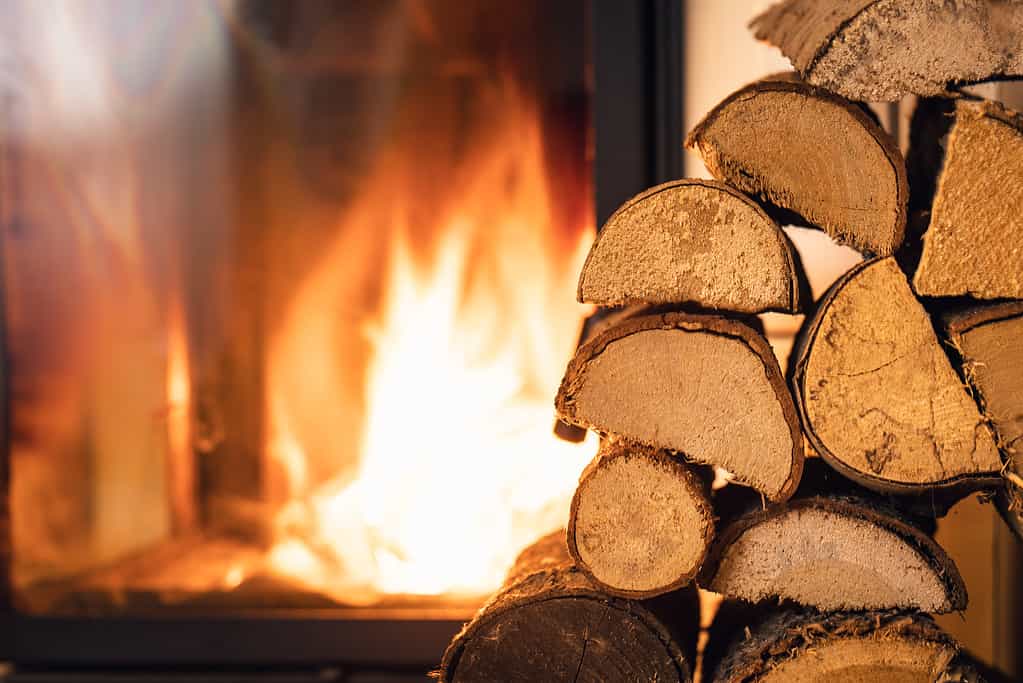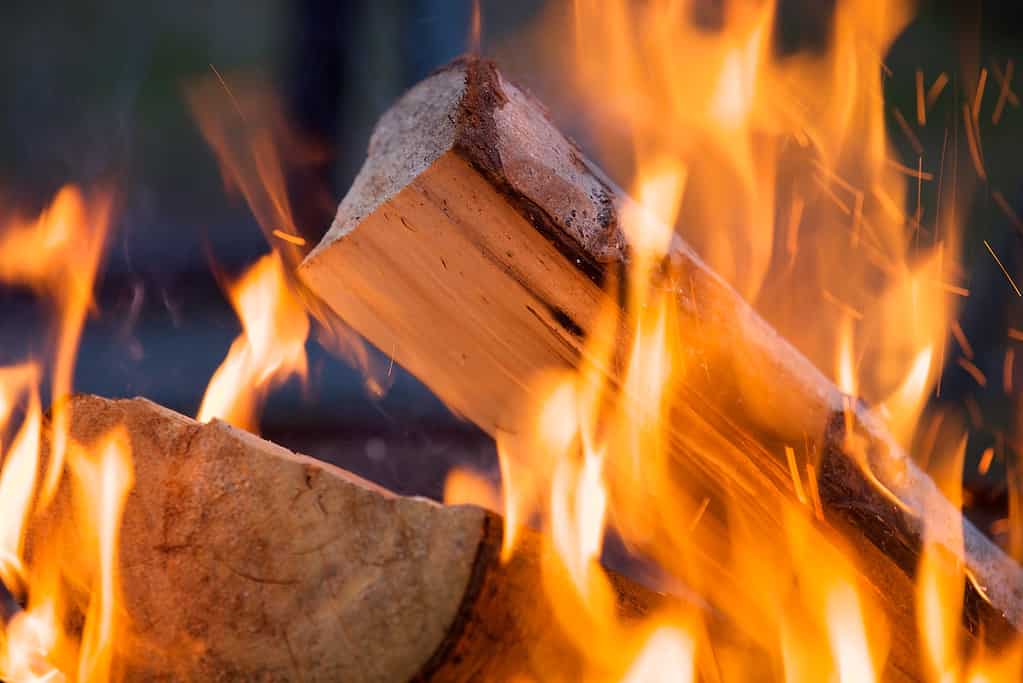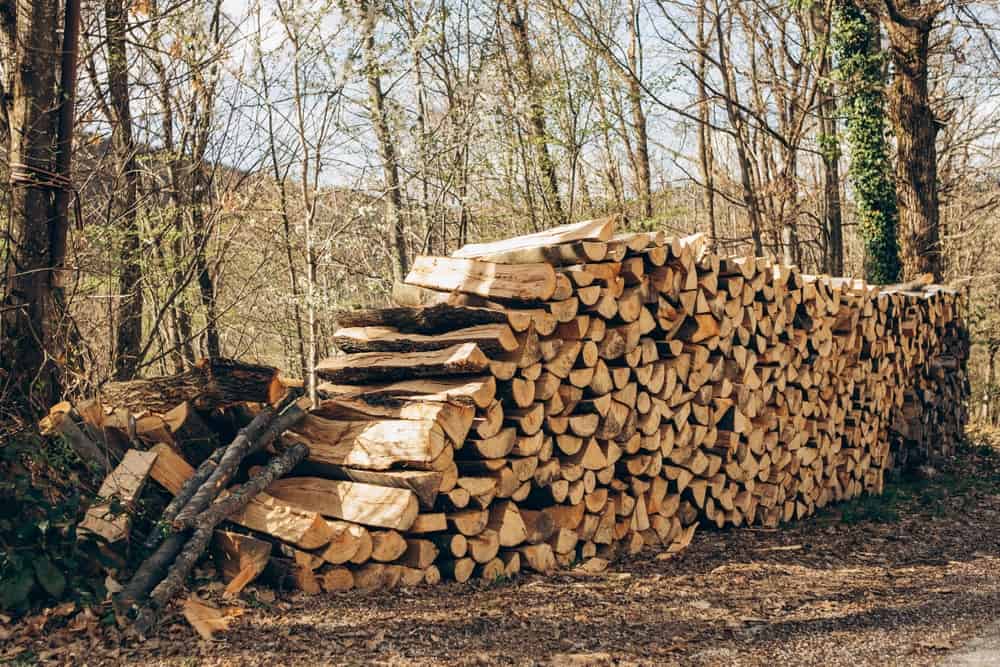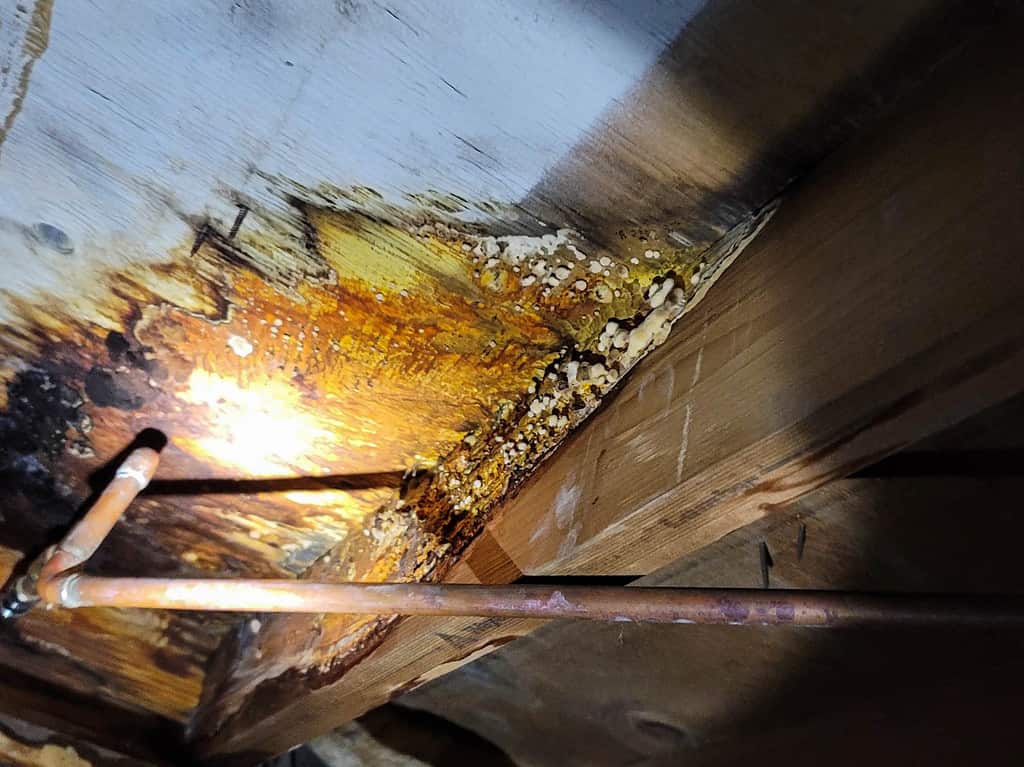There are many wonderful reasons why you might want to begin chopping and storing your own firewood. Maybe you moved to a new home with a wood-burning stove. You might want to have some firewood stored just in case of emergencies. Many people cut their own firewood for backyard fire pits or family gatherings. Whatever the reason, there are important things to keep in mind while sourcing, chopping, and storing your firewood. Here, we will cover the five reasons you should never stack firewood next to your house.
Why You Should Never Stack Firewood Next to Your House

You should have a main stack outside, and a small stack inside just for the day.
©Bastian Weltjen/iStock via Getty Images
If you’ve never chopped and stored firewood before, you might wonder why it feels like that’s all some people do all day. Preparing firewood is a long and laborious chore even if you have a chainsaw and wheelbarrow. However, if you rely on firewood for heat during the cold months, then being prepared with extra firewood in case of emergencies or extra-cold nights is essential. Don’t forget that chopping the firewood is only half the job. Stacking and storing wood properly is important to make sure the wood you burn inside your home is dry, free from parasites, and burns cleanly. One of the most important keys to storing your firewood is to never stack it right against your home. Here is why.
Reason #1: Stacked Firewood is a Fire Hazard

Homes are already fire hazards, don’t make the problem worse!
©© Chuck Moser/iStock via Getty Images
Wood burns. Dry firewood burns really well. Dry firewood stacked against your home filled with electrical wiring, open flame, and other potential for fire (including lightning and accidents) is a disaster waiting to happen.
If you are storing and stacking your firewood properly, it should be dry even during wet seasons. Typically, you should be protecting your firewood with a tarp over the top, or stacking your wood under a roof of some kind, like a shed. Even if you are extremely careful, though, accidents still happen. Small mistakes can turn into giant fires quicker than you expect. When this happens, you want time to put out the fire without damaging your home.
If the fire is stacked against your home, not only will the fire spread to your house much quicker, it will be much harder to put out since you cannot reach all sides of the wood pile. If a wood stack is by itself, you can spray down the fire from all four sides, and even on top. In the worst case, you can even knock the stack over if you have to so the fire has less fuel to burn. You can’t do this if the wood is stacked against your house.
Reason #2: Stacked Wood Adds Weight to Your Home

Small pieces might seem light, but the weight adds up over time!
©iStock.com/Vitelle
There are two ways the weight of the wood pile can affect your home. First, it might begin to lean against the wall. This will add stress to the beams or other materials used to build your home. Your home might not collapse, but it will damage the interior structure of your wall, causing problems down the line. It can also damage the outer wall, making holes for water to get in or compressing internal pipes.
Second, it can add more weight to the foundation that it wasn’t built to support. Wood is heavy. Even modern homes experience some amount of settling over time. Depending on where they are built, this settling can be a few inches, or more, resulting in damage to the home. If you are adding significant weight to one side of the home, this can cause damage to the foundation and alter the natural settling of the structure. This process is so slow that you won’t even notice it happening until the damage is done and it’s too late.
Reason #3: Cut Wood Should be in Direct Sunlight and Away From Walls

Most of the weight in trees comes from water.
©Danita Delimont/Shutterstock.com
Fresh firewood is full of water. It’s that water that gives off that distinct fresh-cut wood smell we all know and love. However, you don’t want to be burning wet wood in your home fireplace. This water doesn’t let the wood burn evenly, causes more smoke, and can make embers and sparks spread up your chimney, which is a fire hazard.
That’s why storing your firewood somewhere it can dry properly is essential. You want to store your wood where it is exposed to the air on all four sides. You also want it in direct sunlight for as long as possible during the day. The movement of air around and through the wood pile will whisk away moisture, drying and seasoning the wood. The direct sunlight will help keep it dry and prevent fungus and rot from setting in.

It’s best to stack firewood away from your home in direct sunlight.
©Ekaterina Vasileva-Bagler/Shutterstock.com
When you stack wood against your home, air can’t pass through the stack effectively. This allows moisture to collect. This promotes fungus and rot, which not only make poor firewood but can also damage your home.
Reason #4: Stacked Firewood is a Perfect Home for Insects and Rodents

Black widows love making homes in wood piles.
©Sari ONeal/Shutterstock.com
Small creatures of all types love stacks of firewood. Particularly, they love firewood piles that are protected on one side by a wall or a building. This gives them a place to live while being safe from other predators and the wind and elements. In North America, dangerous animals like rattlesnakes and black widow spiders will often make their home in wood piles.
Stack your wood in an open area where you can see any signs of animals or insects that might have made their home there. If it is against your home, it is harder to find these creatures and the damage they cause will be much more significant. Aggressive and venomous creatures are a danger to you and your home.
Additionally, if termites or other wood-eating insects are native to your area, the last thing you want is to stack a buffet of dry wood for them to eat right next to your home. Once these insects are inside your walls, it is nearly impossible to remove them without the help of an expert. All it takes is one piece of firewood with termites to touch your home and you’ll have an expensive and annoying termite infestation to deal with.
Reason #5: Wood Stacked Next to Your House Promotes Mold and Rot

This is the kind of damage you can avoid by not stacking your wood next to your house.
©Ethen Dell/iStock via Getty Images
Fungi love dark, wet, and warm environments. The space between stacked firewood, and especially between stacked firewood and the warm walls of your home are perfect places for fungi to grow. It takes time for new firewood to dry out. But even dry firewood creates an environment in which fungus can grow extremely rapidly.
Wood rot and fungus on the outside of your home are ugly and annoying to repair. However, the problem goes beyond that if the fungus has invaded deeper into your walls. No matter how much you kill, remove, and prevent the mold and rot in your walls, if you still have a stack of firewood next to your home, the problem will keep returning.
If you’re going to spend long hours cutting trees and splitting firewood, don’t let all your hard work go to waste by storing and stacking your firewood improperly. One of the worst things you can do for your firewood and your home is to stack that wood against your house. Take the time to find a perfect space close enough to your home so you can access it during winter, but never stack firewood next to your house.
The photo featured at the top of this post is © Bastian Weltjen/iStock via Getty Images
Thank you for reading! Have some feedback for us? Contact the AZ Animals editorial team.






